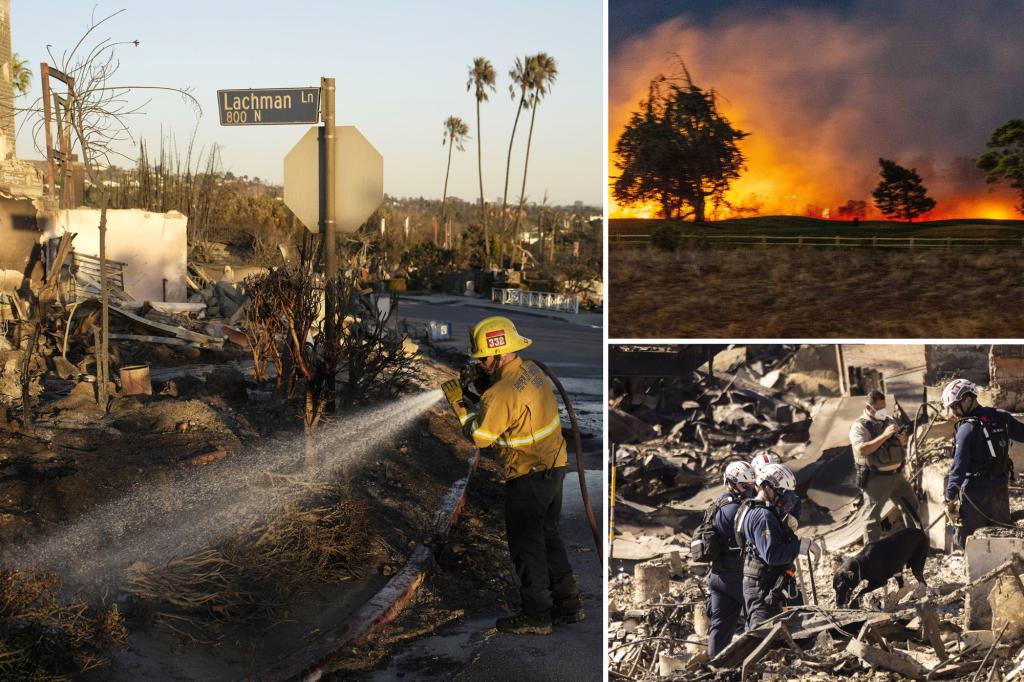The Los Angeles wildfires, which have scorched over 40,000 acres of Southern California, are expected to be brought under control in the coming days, following a week of intense firefighting efforts hampered by strong winds. The largest of these, the Palisades Fire, has consumed roughly 24,000 acres, an area about half the size of Brooklyn, and is currently 17% contained. A key factor in the progress is the abatement of the hot, dry winds that fueled the rapid spread of the fires. These winds, though initially predicted to be severe, have lessened significantly, allowing firefighters to make substantial gains in containment. Experts anticipate continued progress over the weekend as favorable weather conditions persist.
The success of firefighting efforts hinges heavily on weather conditions. The Santa Ana winds, known for their dryness, have exacerbated the fires by carrying dry desert air. A shift in wind direction, bringing moist air from the sea, would be a significant boon to firefighting efforts. Adding to the challenge is a delayed rainy season, with Los Angeles experiencing its second-driest winter on record. Unfortunately, forecasts predict minimal rainfall between now and the end of January, offering little hope of natural assistance in quelling the flames. While the short-term forecast favors containment efforts, the long-term lack of rain presents ongoing concerns about the region’s vulnerability to further wildfires.
Despite the challenging conditions, experts express optimism about containing the fires soon. Over 5,000 personnel are battling the Palisades Fire alone, demonstrating a significant commitment of resources. While authorities might be cautious in officially declaring a fire “contained,” one practical indicator is a stabilization of the reported acreage burned. The acreage tallies for the Eaton, Palisades, and Hurst fires have remained unchanged since Sunday, suggesting that the fires have stopped spreading. This stabilization, coupled with the substantial firefighting force deployed, points to an impending containment of the blazes.
While containment is within sight, fully extinguishing the fires is a different matter entirely. Even after a fire is contained, the process of ensuring its complete extinguishment can be lengthy and laborious. Smoldering fuel underground poses a significant risk, requiring meticulous inspection and monitoring with heat sensors. The urban setting of the fires presents additional challenges, as firefighters cannot simply clear out vegetation to create fire breaks, as they would in a forest fire. The dense infrastructure and residential areas demand a more delicate approach, prioritizing the protection of unaffected structures. Experts predict that it could take a month or more to fully extinguish the fires and ensure no lingering embers pose a threat.
The timeline of the Palisades Fire, originating from a smaller blaze known as the Lochman Fire, reveals the rapid escalation of the situation. The Lochman Fire, initially contained after burning 8 acres on January 1st, reignited on January 7th. Despite early reports of smoke and multiple 911 calls, the fire quickly spread, fueled by strong winds. Within hours, the blaze grew from a small plume of smoke to a raging inferno, engulfing thousands of acres and prompting evacuations. The rapid escalation highlights the volatile nature of wildfires, particularly under dry conditions and strong winds, emphasizing the importance of early detection and rapid response.
Fighting urban wildfires presents unique challenges compared to their counterparts in forested areas. The presence of buildings and infrastructure prevents the typical wildfire management strategy of creating firebreaks by clearing vegetation. Instead, firefighters rely on existing barriers like roads, rivers, and drainage canals as anchor points to contain the fire’s spread. When numerous structures are already ablaze within the perimeter, the focus shifts from extinguishing those individual fires to protecting the surrounding unburned structures. This strategic approach prioritizes resource allocation to prevent further spread, recognizing that extinguishing every burning structure might be impossible given the scale and intensity of the blaze. The fight against urban wildfires becomes a complex balancing act between containment and protection, demanding a careful assessment of risks and resource deployment.










